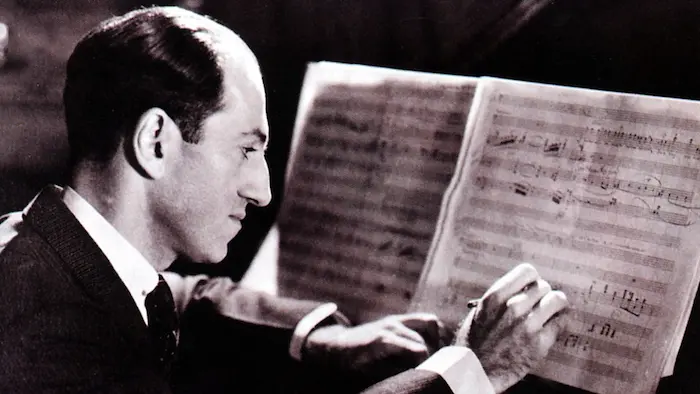Tin Pan Alley was the heartbeat of American popular music from the late 19th to the early 20th century. It was a hub where songwriters churned out melodies that shaped the soundscape of the era. The music produced was accessible, catchy, and often targeted at a mass audience. However, Tin Pan Alley was not typically associated with the more “serious” world of classical music. Classical music, with its roots in European traditions, was seen as a different realm—one requiring formal training, complex compositions, and catering to a more discerning audience. Yet, there was one composer who managed to bridge this gap successfully: George Gershwin.
I. George Gershwin: A Composer of Two Worlds
George Gershwin was born on September 26, 1898, in Brooklyn, New York. From a young age, his talent for music was evident. He started his career in the bustling environment of Tin Pan Alley, writing songs that became instant hits. Yet, unlike many of his contemporaries, Gershwin did not remain confined to the world of popular music. He ventured into classical music, where he made a significant impact. This dual success in both genres sets Gershwin apart as a unique figure in the history of American music.
II. Tin Pan Alley and the Birth of George Gershwin’s Career
The Early Years in Tin Pan Alley
George Gershwin’s career began in Tin Pan Alley, where he worked as a “song plugger.” This job involved playing new songs for potential customers, hoping to convince them to purchase sheet music. Gershwin quickly moved from plugging songs to writing his own. His early work in Tin Pan Alley was characterized by its lively rhythms, catchy melodies, and a distinct American flavor.
Breakthrough with “Swanee”
One of Gershwin’s earliest and most significant hits was “Swanee.” Written in 1919, the song was performed by Al Jolson in the musical Sinbad, and it quickly became a national sensation. “Swanee” sold over a million copies of sheet music, catapulting Gershwin to fame. This success in Tin Pan Alley was just the beginning of his illustrious career.
III. The Transition to Classical Music
A Bold Step into Classical Music
While Gershwin was enjoying success in Tin Pan Alley, he was not content to remain within the confines of popular music. He had a deep respect for classical music and was determined to make his mark in that world as well. This ambition led him to compose Rhapsody in Blue, a piece that would become one of the most iconic works in American music.
Rhapsody in Blue: A Fusion of Genres
Rhapsody in Blue premiered in 1924 and was an immediate success. The piece was groundbreaking because it blended elements of classical music with jazz, a genre deeply rooted in the American experience. The use of jazz idioms within a classical structure was revolutionary, and it challenged the traditional boundaries between popular and classical music. Gershwin’s ability to bridge these two worlds was a testament to his genius as a composer.
IV. The Classical Works of George Gershwin
Porgy and Bess: An American Opera
After the success of Rhapsody in Blue, Gershwin continued to explore classical forms. One of his most ambitious projects was the opera Porgy and Bess. Premiered in 1935, Porgy and Bess was a daring work that combined elements of opera, jazz, and folk music. The opera was based on DuBose Heyward’s novel Porgy and depicted the life of African Americans in the South.
The Challenges and Triumphs of Porgy and Bess
Porgy and Bess was not an immediate success. The opera’s blending of classical and popular music, along with its portrayal of African American life, was controversial at the time. However, over the years, Porgy and Bess has come to be recognized as one of the greatest American operas. Its songs, such as “Summertime” and “It Ain’t Necessarily So,” have become standards in both classical and popular music.
Concerto in F and Other Orchestral Works
In addition to Porgy and Bess, Gershwin composed other significant classical works. Concerto in F for piano and orchestra, premiered in 1925, was another example of Gershwin’s ability to blend classical forms with jazz influences. The piece was well-received and solidified Gershwin’s reputation as a serious composer.
An American in Paris: A Symphonic Tone Poem
An American in Paris, composed in 1928, was inspired by Gershwin’s time in Paris. The piece is a symphonic tone poem that captures the energy and spirit of the city. It was another successful blend of classical and jazz elements, showcasing Gershwin’s versatility as a composer.
V. Gershwin’s Legacy in Classical and Popular Music
A Lasting Impact on American Music
George Gershwin’s success in both Tin Pan Alley and classical music is a testament to his extraordinary talent. He was able to move between the two worlds with ease, creating music that was both popular and profound. His ability to blend different genres and styles has left a lasting impact on American music.
Influence on Future Composers
Gershwin’s work has influenced countless composers in both popular and classical music. His blending of genres paved the way for future composers to experiment with different musical styles. Composers such as Leonard Bernstein and Aaron Copland were influenced by Gershwin’s work, and his legacy continues to be felt in American music today.
See Also: Classical Chinese Music and Its Unique Scales: A Comprehensive Overview
VI. Conclusion
George Gershwin’s ability to succeed in both Tin Pan Alley and classical music is a rare achievement. His work in popular music made him a household name, while his classical compositions earned him respect in the world of serious music. Gershwin’s genius lay in his ability to bridge these two worlds, creating music that was innovative, accessible, and enduring. His legacy as a composer who could excel in both popular and classical genres remains unmatched, making him a unique figure in the history of American music.

